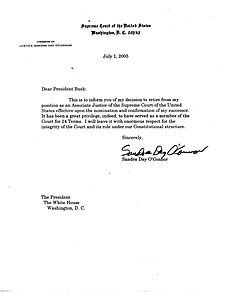Sandra Day O'Connor facts for kids
Quick facts for kids
Sandra Day O'Connor
|
|
|---|---|

Official portrait, c. 2002
|
|
| Associate Justice of the Supreme Court of the United States | |
| In office September 25, 1981 – January 31, 2006 |
|
| Nominated by | Ronald Reagan |
| Preceded by | Potter Stewart |
| Succeeded by | Samuel Alito |
| Judge of the Arizona Court of Appeals for Division One |
|
| In office December 14, 1979 – September 25, 1981 |
|
| Nominated by | Bruce Babbitt |
| Preceded by | Mary Schroeder |
| Succeeded by | Sarah D. Grant |
| Judge of the Maricopa County Superior Court for Division 31 | |
| In office January 9, 1975 – December 14, 1979 |
|
| Preceded by | David Perry |
| Succeeded by | Cecil Patterson |
| Member of the Arizona Senate | |
| In office January 8, 1973 – January 13, 1975 |
|
| Preceded by | Howard S. Baldwin |
| Succeeded by | John Pritzlaff |
| Constituency | 24th district |
| In office January 11, 1971 – January 8, 1973 |
|
| Preceded by | Constituency established |
| Succeeded by | Bess Stinson |
| Constituency | 20th district |
| In office October 30, 1969 – January 11, 1971 |
|
| Preceded by | Isabel Burgess |
| Succeeded by | Constituency abolished |
| Constituency | 8-E district |
| 23rd Chancellor of the College of William & Mary | |
| In office October 1, 2005 – February 3, 2012 |
|
| President | Gene Nichol Taylor Reveley |
| Preceded by | Henry Kissinger |
| Succeeded by | Robert Gates |
| Personal details | |
| Born |
Sandra Day
March 26, 1930 El Paso, Texas, U.S. |
| Died | December 1, 2023 (aged 93) Phoenix, Arizona, U.S. |
| Political party | Republican |
| Spouse | |
| Children | 3 |
| Relatives | Ann Day (sister) |
| Education | Stanford University (BA, LLB) |
| Awards | Presidential Medal of Freedom (2009) |
| Signature | |
Sandra Day O'Connor (March 26, 1930 – December 1, 2023) was an American retired attorney and politician who served as the first female associate justice of the Supreme Court of the United States from 1981 to 2006. She was both the first woman nominated and the first confirmed to the court.
Contents
Early life
Sandra Day was born in El Paso, Texas to Harry Alfred Day, a rancher, and Ada Mae (Wilkey). She grew up on a 198,000-acre cattle ranch near Duncan, Arizona.
The ranch was nine miles from the nearest paved road. The family home did not have running water or electricity until Sandra was seven years old.
Sandra had two younger siblings, a sister and a brother, respectively eight and ten years her junior. Her sister was Ann Day, who served in the Arizona Legislature. She later wrote a book with her brother, H. Alan Day, Lazy B: Growing up on a Cattle Ranch in the American West (2002), about her childhood experiences on the ranch.
Education
For most of her early schooling, Day lived in El Paso with her maternal grandmother, and attended school at the Radford School for Girls, a private school. The family cattle ranch was too far from any schools, although Day was able to return to the ranch for holidays and the summer. Day spent her eighth-grade year living at the ranch and riding a bus 32 miles to school. She graduated sixth in her class at Austin High School in El Paso in 1946.
When she was 16 years old, Day enrolled at Stanford University. She graduated magna cum laude with a B.A. in economics in 1950. She continued at Stanford Law School for her law degree in 1952. There, she served on the Stanford Law Review with its presiding editor-in-chief, future Supreme Court chief justice William Rehnquist. Day was Order of the Coif, indicating she was in the top 10 percent of her class.
Early career
Upon graduation from law school O'Connor had difficulty finding a paying job as an attorney because of her gender. O'Connor found employment as a deputy county attorney in San Mateo, California, after she offered to work for no salary and without an office, sharing space with a secretary. After a few months she began drawing a small salary as she performed legal research and wrote memos. She worked with San Mateo County district attorney Louis Dematteis and deputy district attorney Keith Sorensen.
She volunteered in various political organizations, such as the Maricopa County Young Republicans, and served on the presidential campaign for Arizona Senator Barry Goldwater in 1964.
O'Connor served as assistant Attorney General of Arizona from 1965 to 1969. In 1969, the governor of Arizona appointed O'Connor to fill a vacancy in the Arizona Senate. She ran for and won the election for the seat the following year. By 1973, she became the first woman to serve as Arizona's or any state's Majority Leader. She developed a reputation as a skilled negotiator and a moderate. After serving two full terms, O'Connor decided to leave the Senate.
In 1974, O'Connor was appointed to the Maricopa County Superior Court, serving from 1975 to 1979 when she was elevated to the Arizona State Court of Appeals. She served on the Court of Appeals-Division One until 1981 when she was appointed to the Supreme Court by President Ronald Reagan.
Tenure
Upon her nomination to the Court, O'Connor was confirmed unanimously by the Senate.
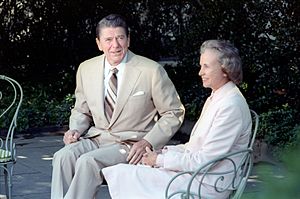
O'Connor said she felt a responsibility to demonstrate women could do the job of justice. She faced some practical concerns, including the lack of a woman's restroom near the Courtroom.
Two years after O'Connor joined the Court, The New York Times published an editorial which mentioned the "nine men" of the "SCOTUS", or Supreme Court of the United States. O'Connor responded with a letter to the editor reminding the Times that the Court was no longer composed of nine men and referred to herself as FWOTSC (First Woman On The Supreme Court).
O'Connor was a proponent of collegiality among justices on the court, often insisting that the justices eat lunch together.
In 1993, Ruth Bader Ginsburg became the second female Supreme Court justice. O'Connor said she felt relief from the media clamor when she was no longer the only woman on the Court.
On July 1, 2005, she announced her intention to retire effective upon the confirmation of a successor. Samuel Alito was nominated to take her seat in October 2005 and joined the Court on January 31, 2006.
During her time on the Court, some publications ranked O'Connor among the most powerful women in the world. Upon leaving the Court, she succeeded Henry Kissinger as Chancellor of the College of William & Mary.
Retirement
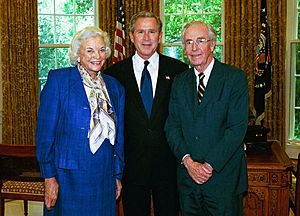
By 2005, the composition of the Court had been unchanged for eleven years, the second-longest period in American history without any such change.
On July 1, 2005, O'Connor announced her intention to retire. In her letter to President Bush, she stated that her retirement from active service would take effect upon the confirmation of her successor. Her letter did not provide a reason for her departure; however, a Supreme Court spokeswoman confirmed O'Connor was leaving to spend time with her husband.
On October 31, Bush nominated Third Circuit Judge Samuel Alito to replace O'Connor; Alito was confirmed by a 58–42 vote and was sworn in on January 31, 2006. After retiring, she continued to hear cases and rendered over a dozen opinions in federal appellate courts across the country, filling in as a substitute judge when vacations or vacancies left their three-member panels understaffed. On Alito's nomination, O'Connor said, "I've often said, it's wonderful to be the first to do something but I didn't want to be the last. If I didn't do a good job, it might've been the last and indeed when I retired, I was not replaced, then, by a woman which gives one pause to think 'Oh, what did I do wrong that led to this.'"
Post-Supreme Court career
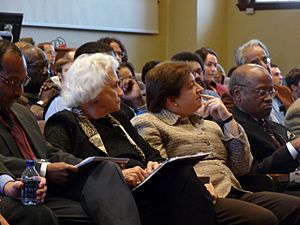
As a retired Supreme Court Justice, O'Connor continued to receive a full salary, maintained a staffed office with at least one law clerk, and heard cases on a part-time basis in federal district courts and courts of appeals as a visiting judge.
The Sandra Day O'Connor Project on the State of the Judiciary, named for O'Connor, held annual conferences from 2006 through 2008 on the independence of the judiciary.
Starting 2006, she was a trustee on the board of the Rockefeller Foundation.
On October 4, 2005, the College of William & Mary announced that O'Connor had accepted the largely ceremonial role of becoming the 23rd Chancellor of the college. O'Connor continued in the role until 2012.
O'Connor was a member of the 2006 Iraq Study Group, appointed by the U.S. Congress.
O'Connor chaired the Jamestown 2007 celebration, commemorating the 400th anniversary of the founding of the colony at Jamestown, Virginia in 1607.
O'Connor was a member of both the American Philosophical Society and the American Academy of Arts and Sciences.
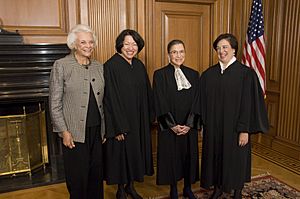
Teaching
As of Spring 2006, O'Connor taught a two-week course called "The Supreme Court" at the University of Arizona's James E. Rogers College of Law every spring semester. In the fall of 2007, O'Connor and W. Scott Bales taught a course at the Sandra Day O'Connor College of Law at Arizona State University.
Publishing
She wrote the 2013 book Out of Order: Stories from the History of the Supreme Court.
Non-profits and philanthropic activity
In February 2009, O'Connor launched Our Courts, a website she created to offer interactive civics lessons to students and teachers because she was concerned about the lack of knowledge among most young Americans about how their government works. She also serves as a co-chair with Lee H. Hamilton for the Campaign for the Civic Mission of Schools. On March 3, 2009, O'Connor appeared on the satirical television program The Daily Show with Jon Stewart to promote the website. In August 2009, the website added two online interactive games. The initiative expanded, becoming iCivics in May 2010 offering free lesson plans, games, and interactive videogames for middle and high school educators. By 2015, the iCivics games had 72,000 teachers as registered users and its games had been played 30 million times.
She served on the Board of Trustees of the National Constitution Center in Philadelphia, a museum dedicated to the U.S. Constitution. By November 2015, O'Connor had transitioned to being a Trustee Emeritus for the center. In April 2013, the Board of Directors of Justice at Stake, a national judicial reform advocacy organization, announced that O'Connor would be joining the organization as Honorary Chair."
In 2009, O'Connor founded the 501(c)(3) non-profit organization now known as the Sandra Day O'Connor Institute. Its programs are dedicated to promoting civil discourse, civic engagement, and civics education. In 2019, her former adobe residence in Arizona, curated by the O'Connor Institute, was listed on the National Register of Historic Places. In 2020, the Institute launched O'Connor U, its multigenerational digital platform. O'Connor served as Founder and Advisor to the O'Connor Institute.
She was a member and president of the Junior League of Phoenix.
O'Connor was a founding co-chair of the National Advisory Board at the National Institute for Civil Discourse (NICD).
Personal life
Day dated William Rehnquist in 1950. Rehnquist proposed marriage but Day did not accept the proposal.
While in her final year at Stanford Law School, Day began dating John Jay O'Connor III who was one class year behind her. Six months after her graduation, on December 20, 1952, Day and O'Connor married at her family's ranch.
When her husband was drafted, O'Connor decided to pick up and go with him to work in Germany as a civilian attorney for the Army's Quartermaster Corps. They remained there for three years before returning to the states where they settled in Maricopa County, Arizona, to begin their family. They had three sons: Scott (born 1958), Brian (born 1960), and Jay (born 1962). Following Brian's birth, O'Connor took a five-year hiatus from the practice of law.
Upon her appointment to the Supreme Court, O'Connor and her husband moved to the Kalorama area of Washington, D.C. The O'Connors became active in the Washington D.C. social scene. O'Connor played tennis and golf in her spare time. She was a baptized member of the Episcopal Church.
O'Connor was successfully treated for breast cancer in 1988 (she also had her appendix removed that year). That same year, John O'Connor left the Washington, D.C. law firm of Miller & Chevalier for a practice which required him to split his time between Washington, D.C., and Phoenix.
Her husband suffered from Alzheimer's disease for nearly 20 years, until his death in 2009, and she became involved in raising awareness of the disease. After retiring from the Court, O'Connor moved back to Phoenix, Arizona.
Around 2013, O'Connor's friends and colleagues noticed that O'Connor was becoming more forgetful and less conversational. By 2017, back problems led to O'Connor needing to use a wheelchair and led to her moving to an assisted living facility. In October 2018, O'Connor announced her effective retirement from public life after disclosing that she had been diagnosed with the early stages of Alzheimer's-like dementia.
Interesting facts about Sandra Day O'Connor
- As a youth she owned a .22-caliber rifle and would shoot coyotes and jackrabbits.
- She began driving as soon as she could see over the dashboard and had to learn to change flat tires herself.
- O'Connor was also made an honorary member of Phi Beta Kappa by the College of William and Mary in 2008.
- On August 12, 2009, she was awarded the Presidential Medal of Freedom by President Barack Obama.
- In 2003, she wrote a book titled The Majesty of the Law: Reflections of a Supreme Court Justice (ISBN: 0-375-50925-9).
- In 2005, she wrote a children's book, Chico, named for her favorite horse, which offered an autobiographical depiction of her childhood.
- Following the death of John Paul Stevens in 2019, O'Connor became the last living Justice to have served on the Burger Court.
Sandra Day O'Connor quotes
- "Do the best you can in every task, no matter how unimportant it may seem at the time."
- "We don't accomplish anything in this world alone... and whatever happens is the result of the whole tapestry of one's life and all the weavings of individual threads form one to another that creates something."
- "I don't know that there are any short cuts to doing a good job."
Legacy and awards
Images for kids
-
Justice O'Connor presents Alberto Gonzales to the audience after swearing him in as U.S. Attorney General, as Becky Gonzales looks on.
See also
 In Spanish: Sandra Day O'Connor para niños
In Spanish: Sandra Day O'Connor para niños


